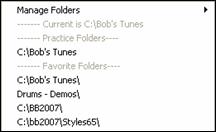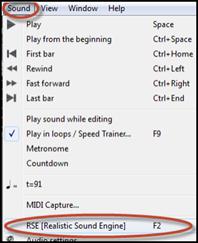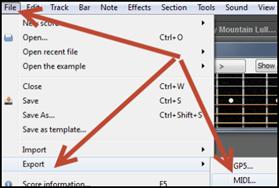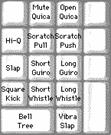Search Manual
Band-in-a-Box® 2023 for Windows® User's Guide
Chapter 12: Wizards, Tutors, and Fun
Video Window
You can load a video that you have already downloaded from YouTube or elsewhere into Band-in-a-Box Video Window. The audio is extracted from the video to the Audio track.
 |
To load and play a video, select the Open File menu item from the [Open] button and choose a video file (mp4/wmv/avi). |
|
Alternatively, click on the [Video] button and select Video Player. Then, when the Video Window opens, click on the [Open] button on its toolbar and select a video file. |
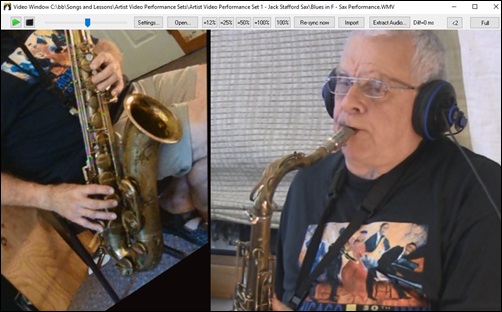
![]() Play, Stop or Move to a position in the video using the Transport toolbar.
Play, Stop or Move to a position in the video using the Transport toolbar.
![]() As the song plays, you can slow down the video, and the audio will slow down and stay in sync.
As the song plays, you can slow down the video, and the audio will slow down and stay in sync.
The quality of the audio at slower tempos is great - better than most video player programs. The video slowdown range is 50-100%. If you want slower than that, you can select values as low as 12%, which is an 8X slowdown (1 second would take 8 seconds), and still has good quality. Note: When set to values lower than 50%, the Video Window is disabled, but the audio continues at the extreme slow tempo. This is a great tool for transcription. You can select a range in the Chord Sheet window and use Transport - [Loop] button to loop a section of the video at a low tempo for example.
You can size the window by dragging the corner.
There is a [Full] button to make the video full screen, and the [Esc] key will go out of the full screen mode.
The [Settings] button will open the Video Settings dialog which allows you to adjust the audio and video playback time.
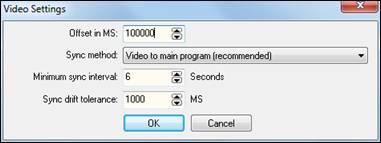
Offset in MS: This will adjust the video playback in milliseconds. A positive value will make the video play later while a negative value will make it play earlier.
Sync method: When the video and the audio are out of sync. “Video to main program” will change the video position. “Main program to video” will change the audio position which may cause a noise. “Do not sync” will never attempt to re-sync.
Minimum sync interval: This allows you to set a minimum number of seconds between attempts to re-sync the video and the audio.
Sync drift tolerance: This allows you to set a maximum drift time in milliseconds between the video and the audio. If they are out of sync less than this value, then the program will not try to re-sync.
“Woodshed” Tempo Feature
When practicing (or “woodshedding”) a tune, it is useful for the tempo to speed up every time the section loops or the song restarts from the beginning.
|
Press the [Practice] toolbar button and select Woodshed (increasing) Tempo… from the pulldown menu. This will open the Tempo Woodshedding dialog. |
For example, if you set the “Woodshed tempo” value to 5 in this dialog, the tempo will speed up by 5 each time the song (or a highlighted section) loops to the beginning. The idea is that you start off with a slow tempo, playing the part perfectly, and keep this up as the song tempo increases.
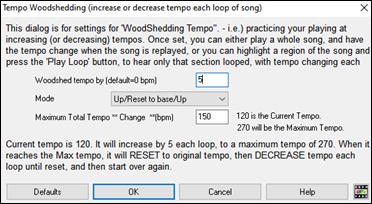
When you press Stop, the tempo reverts to the original tempo.
There are 4 modes to the woodshed tempo field.
- “Up only,” which is getting faster each loop “forever,” well until tempo = 500, which is BB’s maximum tempo.
- An “up then down” mode that goes up by [a settable increment] up to [a settable maximum] and then starts going down by the increment back to the original where it restarts. For example, a song with a tempo of 140, if you set the tempo to increase by 5, to a maximum increase of 100, the song will go from 140,145,150 etc. to 240, then go to 235,230… back to 140 and cycle again.
- An “Up then Reset” mode, that goes up in increments up to the settable maximum, then resets to the original and starts again. For example, a song with a tempo of 140, if you set the tempo to increase by 5, to a maximum increase of 100, the song will go from 140,145,150 etc. to 240, then go to 140 and start again.
- An “Up and stay at Max” mode that goes up until the settable maximum and stays there.
Modes 2 and 3 are analogous to a “treadmill workout,” with programmed changes in speed.
MIDI Wizard - Interpret Chords from MIDI File
Many MIDI files lack chord symbols, making them difficult to play along with by ear. Now you can open any MIDI file in Band-in-a-Box, and Band-in-a-Box will automatically figure out the chords of the song for you. The chords are written onto the Band-in-a-Box Chord Sheet like any other song. You can also read tracks into the Melody and Soloist tracks.
Importing Chords
You can import the chords from a MIDI file. To do this, first blank the Chord Sheet by choosing File | New. Then select the menu item File | Import | Import Chords from MIDI file to launch the Interpret Chords from MIDI File dialog.
Press the [Open (Change)] button to select the MIDI file that you’d like to import.
Once you’ve selected the file, you can press the [INTERPRET CHORDS NOW] button. When you do that, the chords will be interpreted from the MIDI file, and written onto the Chord Sheet. Prior to pressing the [INTERPRET CHORDS NOW] button, you might want to make some custom settings.
When you load in the MIDI file, Band-in-a-Box interprets many things from the MIDI file for you automatically. Normally you’d want this to happen, but if you’d prefer to make the settings yourself, you can set the Auto Interpret settings from MIDI file to false.
Once you have loaded in the MIDI file, and assuming that you have the “Auto Interpret” set to true, you will see that the dialog displays the settings that the Chord Wizard has found for the key signature, and channels used for the song.
Let’s work with an example song called violet.MID. This should be included in the C:\bb\Documentation\Tutorials folder.
- Start with a blank worksheet by choosing File | New.
- Choose the MIDI File chord Wizard dialog by choosing File | Import | Import Chords from MIDI File.
Press the [Open (Change)] button to select the MIDI file, and then choose the file that you’d like to import. In this case, it is C:\bb\Documentation\Tutorials\violet.MID.
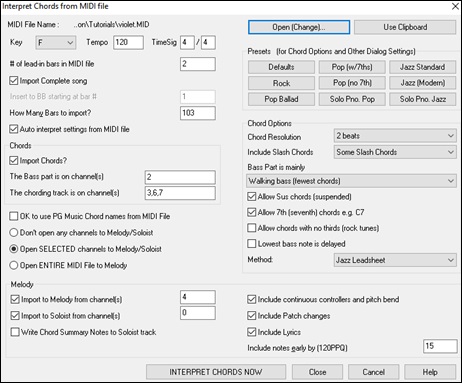
Once you load in the MIDI file, you will see that the Chord Wizard has analyzed it and made these determinations.
It has automatically determined that the violet.MID file
|
|
|
|
|
|
|
|
|
|
|
|
|
|
Now, after loading in the MIDI files, you’d normally have a look at these settings above, to see if they seem reasonable for your MIDI file. If not, you can change the settings. For example, if you knew that the Melody channel was on channel 3, you could override the Chord Wizard settings.

Once you have done that, you should choose one of the Presets, to quickly put the settings to the type of song that we are trying to interpret.
Chord Options: When you choose one of these presets, it makes a number of settings in the Chord Options section of the dialog. You can override them in this dialog.
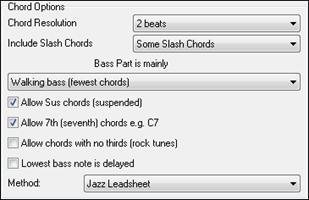
Chord Resolution: This is the minimum number of beats for a chord. For example, if you set it to “2 beats” then the Chord Wizard will never attempt to come up with different chords that are only a beat apart. If you have a song that has a short section that does include chords every beat, you can redo that section of the song with a “1 beat” resolution. (Default = 2 beats)
Include Slash Chords: If set, the Chord Wizard will include “slash chords” like F7/A or Cm/G.
Bass Part Type: You can set this to “Root,” “Root-3-5,” or “Walking Bass.” If you choose “Root,” the chord Wizard will assume that any bass note is the root of the chord. Choosing “Root-3-5” will cause the Chord Wizard to assume that the bass pattern is mainly on the root, 3rd and 5th of the chord. If you choose “Walking bass,” it will assume that the bass notes can be changing and can include many notes beside the root. Setting the Walking bass line will likely result in fewer chords overall than setting the “Root only” option.
Allow Suspended (Sus) Chords: The setting for “Allow Sus chords” determines if chords like Csus or Bbsus7 will be included. The “Allow 7th chords” specifies if 7th chords like C7 or Bbm7 would be allowed. Simple Rock songs might not have 7th chords or Sus chords. Allowing chords with no thirds should be set in a hard rock song, or similar song with “power chords” that might not contain the 3rd of the chords.
Delay Lowest Bass Note: Usually a bass player plays the root of the chord at or near the time when the chord changes. But in solo piano playing or some bass styles, the bass doesn’t state the root until later on, and this setting should be set to “delayed” in a solo piano style of this type.
Primary Style: Set the primary style of the song to Jazz or Pop/Country from the Method combo box.
Using the Chord Options Presets to quickly make settings
For the song violet.MID,” we know that this is a Jazz Swing type of song, so we press the Preset Called “Jazz Standard.” By doing this, we see that the chord options have then been set to Chord Resolution of 2 beats, no slash chords, walking bass, sus chords, 7th chords, and Jazz lead sheet. These settings look OK for our Jazz song, if we wanted to customize it (e.g., to allow slash chords) we could do it at this point.
So, to recap, using the Chord Wizard is a 3-step process.
- We’ve loaded in the song violet.MID.
- Pressing the preset button called [Jazz Standard], we then looked at the Chord Options settings for the various channels and they looked OK, so we didn’t make any changes.
- We then press [INTERPRET CHORDS NOW] – this gets the Chord Wizard to interpret the chords and write them onto the Chord Sheet.
Once we’ve pressed the [INTERPRET CHORDS NOW] button, we can see the results, by looking at the Chord Sheet. Here are the chords that were interpreted.

So that we can see how well the Chord Wizard did, we can compare it to the “correct chords” of the song, input by a musician listening to the song.

As you can see, by comparing the two sets of chords, the Chord Wizard got almost all of the chords correct in this example. The Chord Wizard purposely avoids chords like “C13.” It will put a simpler “C7” instead, since this is more like a typical lead sheet.
If you’ve read in the entire MIDI file, you have 103 bars of chords on the Chord Sheet. This actually contains 3 choruses of the song. You might want to reduce that to a single chorus by setting the chorus end of the song to bar 36 and then erasing the excess bars (after bar 36) by choosing Edit | Erase.
Examining the song that has been interpreted by the Chord Wizard.
You will notice that the title (Violet Song), key (F), and tempo (120) have been set to the values found in the file. Part markers are not set; the Chord Wizard doesn’t try to guess where part markers might be occurring. You need to put the part markers in yourself. You also need to choose the style to use (a Jazz Swing style in this case). If you examine the Melody track (by opening the Notation window and right-clicking on some notes or pressing the Event List (#) button), you will notice that the Melody track contains notes from Channel 4, which is what we specified in the Chord Wizard dialog.
Importing Part of a MIDI file or re-doing a section of the Chord Sheet)

Normally, we’d want to import an entire MIDI file worth of chords, but if you want to import some bars, then deselect the Import Complete song checkbox, and specify where to start in the MIDI file (i.e. the number of lead-in bars in MIDI file), what bar to start at in Band-in-a-Box (Insert to BB starting at bar #), and the number of bars to import (How Many Bars to import?).
Other Settings for the MIDI Chord Wizard
OK to use PG Music Chord names from MIDI File: Band-in-a-Box and PowerTracks Pro Audio songs contain special events that write the exact chord names into the MIDI file. So, if the Chord Wizard sees these events, it will use them instead of interpreting the chords, since they are likely to be completely accurate. If you prefer to ignore these chord events, disable this option.
Write Chord Summary Notes to Soloist track: This setting is only used for diagnostic or special purposes. When set, the Soloist track will contain a special track that has a chord written every 2 beats (or whatever the setting for chord resolution is) that contains every note found for the chord. This shows you the type of logic that the Chord Wizard is basing its decisions on. If you encounter a song that gives incorrect results for the chords, you can try this setting and then examine the Soloist track to see the actual notes of the chords. Chord-stepping through the track (using [Ins] and [Del] on the Numpad) allows you to quickly hear the chords.
Include continuous controllers and pitch bend / Include Patch Changes / Include Lyrics: You can optionally include controllers, pitch bend, patch changes, and lyrics from the MIDI file.
Practice Window
The Practice Window allows convenient “1-click” access to many Band-in-a-Box features that help you with practicing. These include the Ear Training dialog, games (Pitch Invasion etc.), Metronome, CopyMe, Sight Reading, 101 Riffs series, and more.
|
To launch the Practice Window, press the [Practice] button on the toolbar and choose Practice Central from the pulldown menu. You can also go to menu Window | Practice Window or use hot keys Alt+Shift+L. |
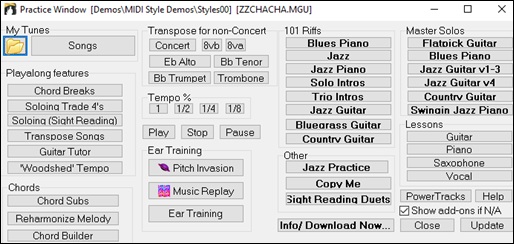
There are several purposes for the Practice Window.
- Quick access to your favorite/preferred “practice” folders, so that you can setup load in songs without having to navigate dialogs.
- One-click access to many of the education-related features of Band-in-a-Box (playalong soloing, ear training games).
- Handy buttons for on-screen transposition for non-concert instruments and for playing at fractions of the original tempo.
- One button access to many of the Band-in-a-Box add-ons “101 Riffs” series and “Master Solos.” (Note: N/A indicates other Band-in-a-Box add-ons that are available, but not installed on your computer.)
- One button access to many other PG Music educational programs and lessons. Most of these items are “add-on” products, available separately, and are not included in the Band-in-a-Box program. If you have these items installed to your hard drive, the Practice Window will find them if they are installed them to the default directories, and if not, you will be able to point the program to the location of the program, which will be remembered in future sessions.
The [Info/Download Now] button opens a page with more information about each of the stand-alone programs and add-ons referred to in this dialog. Internet access is required.
For items that you don’t have, you can choose to display or not display them on-screen using the Show add-ons if N/A setting.
Press the [Update] button if you have just installed an add-on or a program. This will allow you to access it from the Practice Window.
More information about all of the add-on programs can be found at www.pgmusic.com/practice.htm
Making and Using Practice Folders
If you are preparing for a performance or a jam session with friends, you likely have a list of songs that you are working on. Let’s say they are in a folder called C:\Bob’s Tunes.
|
Click on the Folder icon. You will then see a menu that lists a Manage Folders submenu, allowing you to create/remove Practice Folders. |
|
This is list of all Practice Folders defined (there likely won’t be any to start with, so you can add them using the Manage Folders menu command). Add a folder that you use frequently to this list. |
|
After the list of Practice Folders, you see a list of “Favorite Folders” – these are the folders that you have visited recently. Once you have selected a folder, you then press the [Songs] button, and you will see a pop-up menu of the file names for that folder, with the current song having a check mark. Load in a song by choosing the menu item. |
Ear Training Tutor
Ear training is an important exercise for all musicians. Now you can practice your ear training with help from Band-in-a-Box. In addition to the common interval exercises (perfect 4th, minor 2nd, etc.), learning to “play-by-ear” for Jazz and Pop music is further enhanced by ear training exercises to recognize common chord types (e.g., Major, Minor, Dominant, etc.).
For example, Band-in-a-Box will play a chord and you will have to identify the correct root and chord type. Your score can be tracked, allowing you to monitor your progress. Clicking on the various chord types lets you instantly hear the differences between various chords. Other options include “types of roots and chords to use,” and “voicing types” (open, closed, etc.) – allowing you to customize the ear training exercises for beginner through to advanced. Interval recognition is also customizable from beginner to advanced, with such options as instrument type, octave range, up/down intervals and more.
|
|
Press the [Practice] toolbar button and select Ear Training from the pulldown menu to launch the Ear Training Window. Alternatively, press Ctrl+Shift+J or go to menu Window | Ear Training. |
There are 2 modules in the Ear Training Window.
- The Interval Tutor plays note intervals for you to identify.
- The Chord Tutor plays chords (root + extension) for you to identify.
Interval Tutor
Click on the [Interval Tutor] button to launch the Interval Tutor module.
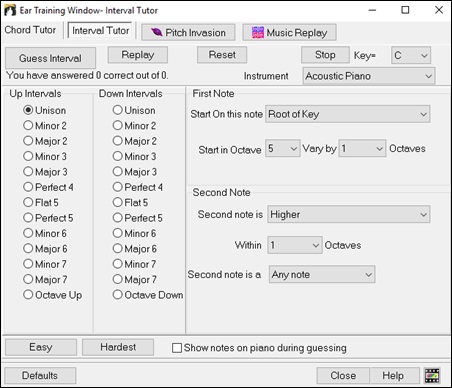
Click on the intervals to hear them. For example, click on “Minor 3” to hear a minor 3rd interval.
Set the interval types to guess. Pressing the [Easy] button will set it to the easiest (within one octave, second note is always higher, etc.).
Start the game by pressing the [Guess Interval] button.
With the First Note and Second Note areas, you can control the starting note and the second note in the dialog.
Once the game starts, click on the interval that you think is being played.
Chord Tutor
Click on the [Chord Tutor] button to enter the Chord Tutor module.
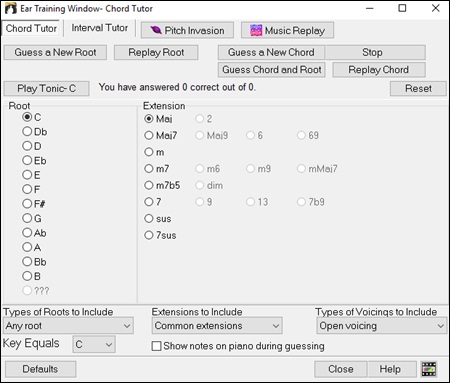
Press the [Play Tonic] button to familiarize yourself with the root note of the scale as a reference point.
- Click on any of the other note names to hear that root.
- Click on any of the chord extensions to hear that sound.
Guessing the root
You can test yourself on roots only or root AND extension. Press [Guess a New Root] and you will hear a root played.
Press this button to hear the root-to-guess replayed. If you need help, press [Play Tonic – C] to hear the root again.
When you think you know the root, press the root name on the list of note names at the left.
If you guess incorrectly, you will see a message that says, “Wrong Root.” You will then hear the note that you guessed playing, followed by the root-to-guess note again.
If you guess correctly, you will see a confirmation of that, and can play again.
Press the [Stop] button to stop the game.
Guessing the Root and the Extensions
The [Guess a New Chord] game works in the same way as the Root game, except that here you are guessing chord extensions. The root is always whatever the setting is at the left. Click on the extension to guess, and [Replay Chord] button to hear the chord again.
In the [Guess Chord and Root] mode, you need to guess both the Root and the Extension. You can guess them in any order.
Click on the root, and when you get it correct you can move on to the extension.
Types of Roots to Include
For the Roots, you can choose which types of roots to include. This can be any of the 12 semitones, or just the scale tones, or just the 1-4-5 of the scale.
Extension to Include
For the extensions, you can include all of the extensions listed in the dialog, or just the subset that are common extensions.
Types of Voicings to Include
The chord extension will be played using the voicing type that you specify in the voicing types combo box. These can be open, closed, or root position voicings. This setting also applies to the voicing used when you are previewing a chord.
Show notes on piano during guessing
If you were an advanced musician, seeing the notes on the piano during the guessing game would be “cheating,” since you’d probably quickly recognize the chord. However, a beginner might benefit from seeing the notes played on the piano screen. If this “show notes on piano during guessing” option is selected, these chords will play on the small piano located on the main program screen.
The score is displayed on the window. You can reset these results to zero by pressing the [Reset] button.
Ear Training Games
Learning is best when it’s fun, so we’ve included these exciting games in the Band-in-a-Box Ear Training module for fun times in “the woodshed.”
Pitch Invasion
Pitch Invasion helps to develop perfect pitch as you shoot down “alien” notes invading from above. You hear the note sound and click on the on-screen piano/MIDI or QWERTY keyboard to shoot it down.

![]() For Pitch Invasion, choose a level that will specify the # of note types that will be invading. The LEVEL determines the speed of the notes.
For Pitch Invasion, choose a level that will specify the # of note types that will be invading. The LEVEL determines the speed of the notes.
To shoot the aliens, click on the on-screen keyboard, MIDI keyboard or QWERTY keys.
![]() The program settings allow you to customize the game.
The program settings allow you to customize the game.
![]() Press the [?] button for more information.
Press the [?] button for more information.
Music Replay
Music Replay develops your pitch, rhythm, and melody recognition by replaying what the program plays, in note, rhythm, or melodic modes.
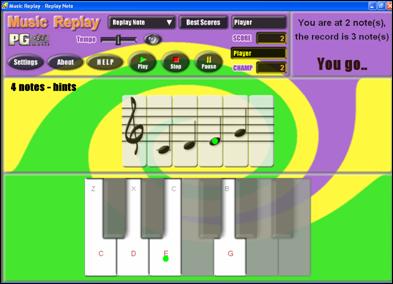
For Music Replay, choose the MODE of the game.
There are three modes:
- Note Replay
- Rhythm Replay
- Melody Replay
![]() Set the Level to make the game harder.
Set the Level to make the game harder.
![]() Press the [HELP] button for more information.
Press the [HELP] button for more information.
Vocal Wizard
The “Vocal Wizard” displays the best song keys for your vocal range!
This feature helps you choose the best song key for your vocal range. Open the Vocal Wizard, enter your vocal type (baritone, tenor, etc.), or choose a custom range. Then the wizard analyzes the song and recommends the best keys for that song. Options available to “include/exclude falsetto range,” “restrict choices to these keys […],” and “transpose now.”
Before we enter the Vocal Wizard, we’re going to load in the song Old Folks at Home.MGU (present in the C:\bb\Documentation\Tutorials\Tutorial - BB2005 folder). This song is in the key of F, so we will use the Vocal Wizard to find the best key for a baritone.
To enter the Vocal Wizard, choose the menu item Window | Lyrics | Vocal Wizard.
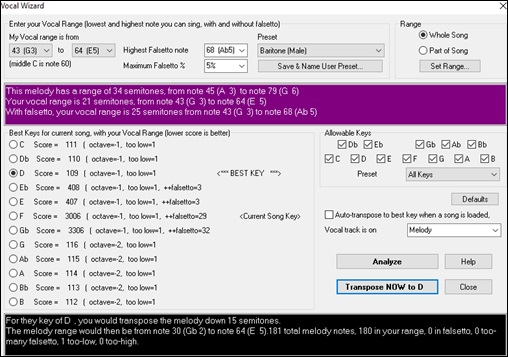
You can see from the screenshot that the Vocal Wizard has picked the key of D (colored green) as the best key for the song, using the baritone vocal range. Other recommended keys are colored yellow. Un-recommended keys are colored grey and include the current key of the song (F).
Let’s explore the areas of the Vocal Wizard screen.
There are 4 areas that require your input.
1. Entering your Vocal Range.

Here you enter your “comfortable” vocal range, from lowest note to highest note. If you can sing falsetto, you can also enter the highest falsetto note, and the % of falsetto notes that would be acceptable as falsetto notes.
You can also select a preset (like Baritone Male or Contralto Female). Or you can select one of 8 “User Preset slots” to enter and save a custom range (if you press the [Save & Name User Preset] button)
2. Selecting the keys that would be “allowable.”

Most musicians have favorite keys, so this area allows selection of keys that would be acceptable for the Vocal Wizard to choose. For example, if we choose “Jazz” keys, we will see that the Vocal Wizard now recommends the key of C instead of D.
3. Setting the range of the song to analyze (usually the whole song). Normally you’d want to analyze the whole song, but this allows you to select a partial range.

4. Selecting the track to analyze. You’d usually pick the Melody track but can also choose the Soloist track.
![]()
You can then analyze the Melody by pressing the [Analyze] button. Most functions automatically re-analyze the song but pressing this button forces a re- analysis of the song. This displays the analysis of the song.
A purple area describes the current range of the song, low note to high note, and compares it to your vocal range.

The radio buttons show each of the 12 semitone keys and show a score for each key. The lowest score is the best.
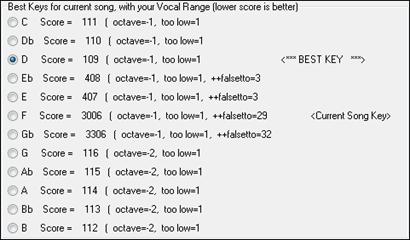
In the example Old Folks at Home, you can see that D is the best key, but any of the keys from G to Db are also good keys in the selected vocal range.
The area in black at the bottom gives an analysis of the vocal range if the song was transposed to the chosen key.

![]() Now that the Vocal Wizard has told us the best key for this song, we can either close the dialog, or transpose it now to the recommended key (or any other key that we have selected with the radio buttons.
Now that the Vocal Wizard has told us the best key for this song, we can either close the dialog, or transpose it now to the recommended key (or any other key that we have selected with the radio buttons.
The Vocal Wizard can also work in an automatic mode, transposing a song to the best key as soon as it is loaded, without having to visit the Vocal Wizard dialog. This is done by checking the “Auto-transpos to best key when a song is loaded” option. By doing this, you can ensure that any song you load will be in the best key for your vocalist! And if the key isn’t deemed to be ideal, just visit the Vocal Wizard to see an analysis of the ranges to pick an alternate key.
Rhythm Guitar Chord Tutor
Use the Guitar Tutor to analyze any song. This feature will show the chords that are playing on the virtual guitar fretboard, in your choice of a Jazz, Pop, or Folk perspective. The Guitar Tutor is a fun way to learn about new guitar chords while playing along with your favorite Band-in-a-Box tune.
The Rhythm Guitar Chord Tutor is most useful on styles that aren’t guitar styles, because the guitar styles already have a guitar part that you can learn from. Using the tutor, you can see (and optionally hear) guitar chords played on the guitar fretboard. This teaches you how to play the chords on guitar.
![]()
![]() To turn the Rhythm Guitar Chord Tutor on, launch the Guitar Window and press the [Tutor] button.
To turn the Rhythm Guitar Chord Tutor on, launch the Guitar Window and press the [Tutor] button.

Enable Chord Tutor Display: This setting silently displays the chords on the guitar fretboard.
The Display Chords EARLY by (120/PPQ) is an “anticipate” mode that plays the next chord X beats in advance, allowing time for the user to prepare. If set to 120, the tutor chords will appear a full beat early.
Play Chords through MIDI: To hear the chords, select the “Play Chords through MIDI” checkbox.
Guitar Patch: You can select the patch to use directly from the Tutor dialog.
Type of chords to display: The tutor will display Jazz, Pop, and Folk voicings in easy, medium, and advanced forms. The advanced forms use inversions, and changing patterns of chords, while the easier ones just stick to the common “campfire” chords. Half Note (sax) chords use the advanced Jazz Guitar “highest-4-strings-comping mode.” This usually plays on the 4 highest strings, and it plays several chords over a single chord. For example, for 2 bars of Cmaj7 it might play Cmaj7-Dm7-Ebdim-Em7 all played as half notes. There are also tutors for the alternate tunings like DADGAD, Open G, etc. They can be selected from this drop-down list.
Show muted high note of 3 note comping: One of the tutors uses 3 note Jazz voicings to simulate the famous Big Band chord guitar comping styles. If you use this, you will only see 3 notes in the chords of course. Since it sometimes helps to see the entire 4 chord voicing in this case, there is the option to show the muted note as well.
Copy to melody track / Copy to Soloist track: Pressing either one of these buttons will send the chord to the appropriate track.
The Guitar Tutor stays enabled until you change the Guitar track to another track (for example, to change it to the Bass track). You can easily re-enable it by clicking on the [Tutor] button again.
Guitar Window
This is a window for guitar and bass players! The on-screen fretboard displays any track on guitar, bass, mandolin, ukulele, or banjo. This feature has many option such as auto-setting of correct positions, notes named on-screen, auto-octave adjust to play in selected position, and a resizable guitar fretboard.
Launching the Guitar Window
|
To launch the Guitar window, press the [Guitar] button in the Views toolbar, or Ctrl+Shift+G, or choose the Window | Guitar Window menu item. |

Notice the various areas of the Guitar window.
- The top title bar states the key of the song, the current track, and the fret position.
- The fretboard is displayed with the highest notes of the guitar at the top, and the open position of the guitar on the left.
- There are names for the open strings displayed on the left (E B G D A E).
- There are fret positions marked at the bottom of the fretboard. You can click on these positions to change the current fret position. Right-clicking on a fret position will set a capo at that fret.
- There are Note Names displayed for two positions on the guitar fretboard. One of the positions is the scale beginning with the third of the scale on the lowest string. In the key of F, this is the 5th position beginning on an A note (the third of the scale). Because it begins on the third of the scale, this position is referred to as the Phrygian Position (since an A Phrygian scale is the same as an F scale). Similarly, the other popular scale is the scale beginning on the 6th of the scale, in the key of F, this is up at the 10th position, and is called the Aeolian Position.
- There are note names displayed in color, with ellipses around the notes that are in the scale. The root note of the scale is highlighted in red, the third and fifth of the scale are in purple, and the rest of the scale tones are circled in gray.
- Pitch bends show up on the Guitar Fretboard. As the pitch bend occurs, a blue line moves along the string in real time, illustrating the height of the pitch bend. Load in the C:\bb\Documentation\Tutorials\Tutorial - BB2005\Pitch Bend on Guitar Demo.MGU song. You will then see pitch bends written as a blue color moving along the string.
- A capo is drawn if you set a capo value with the [Chord Display] toolbar button menu.
- Clicking on the [x] button on a string will delete the notes on just the channel of that string on the current notation time line. Clicking on the bottom [x] button will delete all notes on the current notation time.
- Clicking on a note will delete the note from the Notation window if the note is currently highlighted. If no notes are highlighted in red, then clicking on a note will first delete any notes on the current notation time line and channel before inserting a new note.
- It supports the left-handed (in addition to right-handed) guitar and student view. The he student view is the view a student (or YouTube video watcher) would have of the (right-handed) guitar facing him with the head at the right and low notes at the top. There's also a left-handed student view, so all 4 possible views are supported. To change the view, open the Guitar Settings dialog with the [Settings] button.
Automatic Settings for Guitar Display
Band-in-a-Box does a lot of things automatically on the Guitar window to ensure that the notes are displayed intelligently on a guitar fretboard. These include:
- Automatically setting the two positions that will display the note names based on the key.
- Auto-Scanning the track to be played and adjusting the display octave on the guitar fretboard to ensure that the best octave is picked to minimize the number of notes that will be outside of the current position displayed on the fretboard.
- After Auto-scanning the track, the best position for displaying the music on the guitar is determined. This is always one of the two positions, Aeolian or Phrygian, though you may over-ride this by clicking on any fret position.
- Color-coding note displays. In addition to the note names being outlined in the colors, when the note is played it is highlighted in green if it is a scale note and yellow if it is an out-of-scale note.
Alternate Guitar Tunings
The Guitar window supports alternate tunings, including DADGAD, Drop D, Double Drop D, Open G, and 11 others. You can also select “Nashville High Strung” tunings, which tune certain strings up an octave. These tunings are supported in Styles, Chord Diagrams, Guitar Tutor, Notation, Tab, and Printout. Learn how to play these tunings by watching the on-screen Guitar Fretboard or Notation/Tab window. Easily change any style to use the alternate tuning that you want.
In this discussion, we will be referring to DADGAD tuning, a popular alternate tuning. The same reasoning applies to all of the other alternate tunings available.
There are four ways you can use Band-in-a-Box playing in DADGAD (or any alternate) tunings.
- See any Melody (or Soloist track) displayed in DADGAD tuning. This will display on the guitar fretboard, tab, and printout.
- See guitar parts (chording etc.) in DADGAD tuning, using correct chord shapes. For this, choose a style that has DADGAD tuning, and view the guitar part.
- Use the Guitar Tutor, to view DADGAD chording for any style.
- View guitar chord diagrams in DADGAD tuning, by setting the Notation Window Options “Guitar Chord” to “DADGAD.”
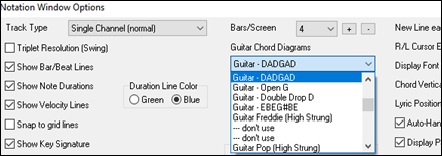
Guitar Fretboard
To see the guitar neck displayed in DADGAD, choose Melody | Track Type | Guitar – DADGAD Tuning.
|
When you open the Guitar window and choose the Melody track, you will see the DADGAD tuning. |

Any melody will now display in the chosen tuning. Similarly, you can set the Soloist track to an alternate guitar tuning with the Soloist | Track Type menu.
The Guitar track (or Piano, Strings) is controlled by the style, and will only reflect the type of tuning stored in the style. Load in some alternate tuning styles included in Styles Set #44 – Requested 4 to see guitar chording in alternate tunings. Another way to see the guitar play chords in alternate tunings is to use the “Guitar Tutor.”
![]() Select DADGAD tuning and enable Guitar Tutor.
Select DADGAD tuning and enable Guitar Tutor.
Now, during playback, you will see guitar chords on the guitar fretboard in DADGAD tuning.

The examples above are for DADGAD tuning but apply similarly to all 11 alternate tunings included.
Guitar Window Toolbar
![]()
The [Setting] button opens the Guitar Settings dialog, which allows you to set the guitar options.
The [<] [>] [<-] [->] buttons will chord step advance or note-step advance. The chord step advance is the most commonly used function. It is also accessible by the hot keys Ins and Del on the numeric keypad and will advance or go back one chord at a time, leaving the chord displayed on the guitar.
You will see the name of the current note that the mouse is over. If you click on the guitar at that position, the note will sound. If the Notation window is open (in Editable Notation or Staff Roll mode), that note will get inserted on the notation at the current position on the time line – you can disable that option to insert notes.
To change the track to display, click on the track selector button and select a track from the menu. You can also hover the mouse cursor over it and use the mouse wheel to quickly switch tracks.
The [Tutor] button runs the Guitar Tutor.
The [POS] button toggles between the two popular positions displayed with note names.
The [Chord Solo] button generates a guitar chord solo based on the existing Melody track using correct guitar fret positions.
When you have a note or chord highlighted press the [Ch-] or [Ch+] (insert guitar chord) button on the guitar, or [7] or [8] on the NUMPAD keypad. Each time you press the [Ch-] or [Ch+] you will see that the guitar chord changes to a different voicing, cycling through the available 5-10 voicings possible for each chord. (Some notes won’t have any chord voicings, for example a C# note on a Cmaj7 chord, because it is always a passing tone.)
In a similar manner, you can convert a chord to a guitar note using the insert guitar note button. Pressing the [N+] (or [3] or [4] on the NUMPAD keypad) repeatedly cycles through playing the same note on all 6 strings.
Guitar Settings
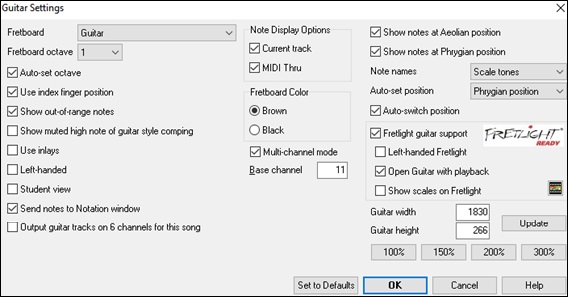
The Guitar Settings dialog allows you the ability to adjust various parameters on the virtual guitar fretboard so that music can be displayed effectively (and easily) on this window, regardless of the original instrument intended for the track data. It also offers the ability to enter notation using the virtual guitar and play back track data in specific fretboard positions for educational and sight-reading purposes.
Fretboard: You can choose the regular guitar, bass, ukulele, mandolin, banjo, and violin as well as the alternate tunings available in Band-in-a-Box, such as DADGAD, Double Drop D, and Nashville high-strung tunings.
Fretboard Octave: For example, if the music is very low and you need to boost the octave to display it on the guitar, set the octave to 1 or 2.
Note Display Options: You can choose what will be displayed on the guitar fretboard. If MIDI Thru is selected, the fretboard will display the music played on a MIDI keyboard. If Current Track is selected, the current track will be displayed. You can select to display both.
Multi-Channel Mode: If this is enabled, the guitar will display information on multi channels on guitar strings 1 to 6. The channels will be determined by the Base Channel below.
Base Channel: (default=11) This determines the starting channel when the Multi-Channel Mode is enabled. If this is set to 11, channels 11 to 16 will be used for guitar stings 1 to 6.
AutoSet Octave : If this is enabled, the octave will be set automatically.
Use Index Finger position: If this is enabled, the scale will use the index finger, instead of the little finger, to play notes that are one fret outside of the normal position.
Show out-of-range notes: Enable this if you want to see any note displayed on the guitar even if it is out of the guitar range.
Left-Handed: With this option, the Guitar window displays for the left-handed users.
Student View: This is a view a student (or YouTube video watcher) would have of the (right-handed) guitar facing him, with the head at the right and low notes at the top. (With the combination with Left-Handed and Tutor Mode options, the Guitar window has 4 possible views - Right-Handed, Left-Handed, Right-Handed & Student Vidw, Left-Handed & Student View.)
Show muted high note of guitar style comping: If this is enabled, the applicable high note that is muted or left out with three note jazz voicings will be displayed.
Fretboard color: The fretboard color can be brown or black.
Use Inlays: Enable this option if you want to see a guitar inlay along the neck.
Send Notes to Notation Window: If this is enabled, clicking a guitar string will insert a note at the current time line on the Notation window.
Output guitar tracks on 6 channels for this song :If this is selected, notes played on each of the six guitar strings will be assigned to one of six different MIDI channels.
Show Guitar Notes at Aeolian Pos. / Show Guitar Notes at Phrygian Pos: The note names can be displayed at the Aeolian position, the Phrygian position, or both.
Note Name: You can choose which notes will be displayed on the fretboard. Options are None, Root Only, Chord Tones, and Scale Tones.
Auto-Set Position: Positions can be set automatically to None, Aeolian, or Phrygian.
Auto-Switch position: This option automatically chooses the best position when a track is loaded.
Fretlight Guitar Support: The Fretlight is a hardware guitar, which has red LED lights on the frets. (See www.fretlight.com for more information.) If this option is enabled, information on the Guitar window will be displayed on the Fretlight.
Left-Handed Fretlight: Enable this if you have a left-handed Fretlight guitar.
Open Guitar with Playback: The Guitar window must be open for the Fretlight to receive guitar notes in Band-in-a-Box. Enable this option so that the Guitar window will open every time play is pressed.
Show Scales on Fretlight: If this is enabled, the scales that show on the Guitar window will also show on the Fretlight guitar.
Guitar Width /Guitar Height / [Update]: The Guitar window can be sized by typing in the values or pressing the preset buttons. When you type in values, press the [Update] button.
Displaying MIDI files from Guitar Pro® on the Guitar Fretboard
MIDI files can be read from Guitar Pro® and displayed correctly on the Guitar Fretboard in Band-in-a-Box. You can then import the audio file, and using Audio Chord Wizard, you can sync up the original audio recording with the Guitar Pro® MIDI file. So you then listen to the original audio as you watch the guitar transcription (from Guitar Pro® playing in Band-in-a-Box).
To export MIDI files on 6 channels in Guitar Pro®, you need to:
|
Turn the RSE off (menu Sound - Realistic Sound Engine). |
|
|
Press the Guitar Settings button on the left of the Guitar Pro® window and then enable the force 11-16 channels option. |
|
Export the Track (menu File - Export - MIDI). |
Then, in Band-in-a-Box, click on the [Open] button and choose the menu itemOpen Entire MIDI File (.mid) to Melody Track to load a Guitar Pro® MIDI file into Band-in-a-Box.
You can then play the file and watch the guitar fretboard to see it. Band-in-a-Box has a large guitar fretboard, sizable with many options, so you may like displaying some of your Guitar Pro® files in Band-in-a-Box.
Big Piano Window
The Big Piano window can display the notes of any track on a resizable piano keyboard. You can also set the range of the piano and number of octaves to display. Additionally, you can display notes names or guide notes --showing the scale notes of the current key. Notes can be displayed using a different color for each note. There’s an “Auto-Octave” setting that will scan the track to be displayed and auto-size the piano to the largest size that would display all of the notes. This “Big Piano” makes it easier to learn piano parts from within Band-in-a-Box.
|
The Big Piano window is launched (or closed) by pressing the piano icon on the Views toolbar, or by pressing Ctrl+Shift+N, or choosing Window | Big Piano Window. |

- The default settings for this feature can be customized by pressing the [Settings…] button.
- The Big Piano window displays a single track on the piano.
- The piano can be resized by dragging the bottom of the window to enlarge it vertically.
- The key of the song is displayed at the top.
- The range of the piano is set automatically (based on the actual notes in the track) to show the largest possible piano).
- The notes of the scale are circled on the piano, with the note names included.
- The root of the scale is colored in red. As the song plays, scale tones are colored green; other notes are colored yellow.
- The name of the note that the mouse cursor is over is highlighted at the top of the window. Clicking on the Big Piano plays a note (using the Thru part) and this can be recorded or sent to the Notation window when entering notation.
- RealTracks (and MIDI style) piano parts that are on the piano track will appear with hands-split (right hand in red, left hand in blue) in the Big Piano window.
- Clicking on the black area to the left of the piano will delete highlighted red notes from the Notation window. If no notes are highlighted in red, then clicking to the left of the piano will delete any note on the current notation time line.
- Clicking on the [x] button will delete highlighted red notes from the Notation window.
Big Piano Settings
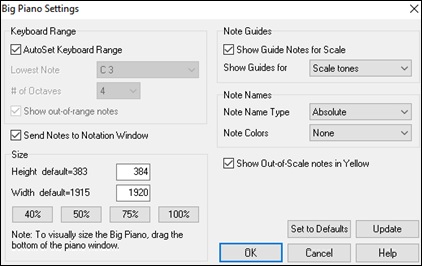
This dialog allows you to set various options on the Big Piano.
- You can set a specific range for the Big Piano, a starting note and a number of octaves, by over-riding the “auto” settings.
- “Show out-of-range notes” ensures that all notes will be displayed.
- If the “Send Notes to Notation Window” checkbox is enabled, clicking a virtual key on the big piano will insert a note to the notation track. (Note: The Notation window must be opened and set to editable notation mode.)
- If “Note Guides” is selected, guide notes will be shown on the keyboard. The guide notes can be scale tones, chord tones, or roots only.
- Note Names and Note Colors can be used as in the Notation settings.
- There is an option to Show Out-of-Scale notes in Yellow.
- The size of the piano keyboard can be entered in pixels, or set with the preset buttons, or set by dragging the bottom border of the window.
Dynamic 3D Drum Kit Window
This sizeable drum window is an animated 3D display of a complete MIDI drum kit with all 61drum sounds displayed on their respective instruments. Watch the drums being played or play-along/record by using QWERTY keys or a mouse.
|
To launch the Drums Window, click on the [Drums] button in the View Panel. |
- Watch the drums being played on the Drums window in real time.
- Play along with the drums in real time by clicking on the drum instruments or using the QWERTY keys. The computer keyboard, the piano key number, and sound names can all (optionally) be made visible on the hint line by moving your mouse cursor over a given instrument.
- Record a drum part into Band-in-a-Box.
Drum Display
All the General MIDI percussion instruments are shown. Some percussion instruments are triggered by multiple MIDI notes. When a sound is controlled by more than one MIDI note, a percussion instrument will show different behavior in response to the different notes. For instance, the Hi-Hat responds differently to Close Hat, Pedal Hat, and Open Hat MIDI notes.
The Drum Kit window can be resized to tile or fit with other windows of interest, or the drums can be moved off-screen. The window looks best if your computer display is in High Color (16 bit) or True Color (32 bit) video mode.

The onscreen instruments may be played by mouse clicking or by pressing the appropriate computer keys. There is an option to display all the QWERTY names on the drums at the same time, so that you can see what keys to hit without having to mouse over the instrument. When playing by mouse click or computer keys, the Shift key can be used to switch the velocity between two user-specified levels (i.e. loud=100 and soft=50).
The drums that you play show up in green; the computer played drums are red.
The multi-note instruments send different MIDI notes to your sound source, depending on where you “click” on the instrument. For instance, the Kick Drum can send three different notes: Ac. Bass Drum (MIDI note 35), Bass Drum 1 (MIDI note 36), and Square Kick (MIDI Note 32).
Control Buttons
Record: Puts Band-in-a-Box in Record mode so drums can be recorded.
Play: Starts song playback.
Rewind: Stop and return to song start.
Stop: Stops song playback.
Size Buttons 1/1 - 1/2 - 1/4: Clicking on these buttons changes the size of the drums window to full size, half size, or quarter-size. (You can also resize the drums window to any size by dragging a window border.)
Settings: Adjusts program behavior. See settings window section below.
Computer “QWERTY” Keys
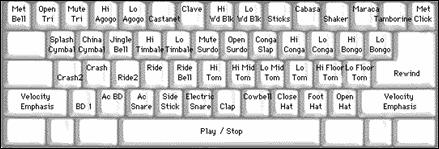
Numeric keypad
|
Press computer keys to play drums. |
Multi - Note Instruments
Kick Drum - Ac. Bass Drum, Bass Drum 1, Square Kick
Snare - Acoustic Snare, Side Stick
Hi-Hat - Closed, Pedal, Open
Floor Tom - Low, High
Electronic Pad - Multi-zoned for Hi-Q, Slap, Electric Snare
High Conga - Mute, Open
Surdo - Mute, Open
Cuica - Mute, Open
Metronome - Bell, Click
Whistle - Long, Short
Triangle - Mute, Open
Guiro - Long, Short
Scratch - Push, Pull
Settings Dialog
Press the Settings button (to the left of Rewind button), to adjust the various Drum Kit Settings.
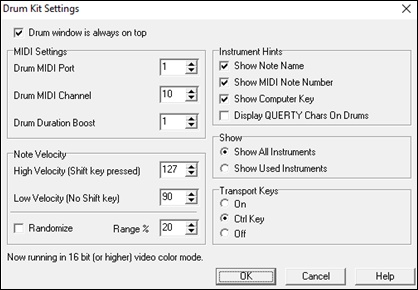
Drum window is always on top: Use this checkbox to keep the Drums window on top of other program windows.
Note Velocity: When playing drums with a mouse or computer keys, the shift key toggles between two levels of note velocity. The two velocity levels can be set any way desired. For instance, if you want the shift key to send quieter notes you can set the shift velocity lower than the non-shift velocity.
Randomize: Use this checkbox to enable the program to send random velocity levels when playing the drums. This is handy when using non- velocity sensitive devices. “Range” controls the amount of velocity randomization. Usually a small range works best, around 10% to 30%. For example, if velocity is set to 127, and the random range is set to 20%, notes would randomly vary between a maximum velocity of 127 and a minimum velocity of 102.
Instrument Hints: Customize the appearance of the Hint line.
- Show Note Name
- Show MIDI Note Number
- Show Computer Key
Show
- Show All Instruments” shows all instruments in the drum window.
- Show Used Instruments” displays the basic trap kit but does not display any extra instruments unless they are used in a song.
The drum window is cleared each time Play or Stop is pressed.
Chord “Breaks”
This feature is great for practicing tempo control.
Select the # of bars, and Band-in-a-Box will play for, say 4 bars (selectable), and then will rest all instruments for the next 4 bars. During the silence, you keep playing (comping, drums, melody, etc.), trying to stay in tempo. Drummers can mute the drum part. When the band comes back in after the 4 bars, you will get instant feedback on how well you have maintained the tempo, as indicated by whether the band comes back in time with you or not.
Once set, this feature works automatically with all songs until you turn it off.
![]() To access the Chord Breaks feature, press the [Chord Breaks] button from the Practice Window and then select “Insert Breaks.”
To access the Chord Breaks feature, press the [Chord Breaks] button from the Practice Window and then select “Insert Breaks.”
![]()
![]() It can also be launched from [Prefs] [Arrange].
It can also be launched from [Prefs] [Arrange].
 |
You then choose how many bars the program should play, and how many bars the program should not play. |
This setting remains in effect for all songs. Turn it off if you want to resume normal playing of songs.
Scale Wizard
The Scale Wizard allows you to easily generate scales, which appear as notation on the Soloist track. Options include Instrument Range, Patch Selection, Jazzy Mode (will use Lydian dominant scales for some 7th chords), and Diatonic Mode (keeps scales relative to the song key).
You can access this feature from the Soloists | Scale submenu.
![]()
The menu item Generate Scales opens the dialog, which allows you to set options for scales that will be generated. If Auto-Generate Scales when play pressed is checked, scales will be automatically generated when a song is played. You can view the scales in the notation and the on-screen guitar and piano.
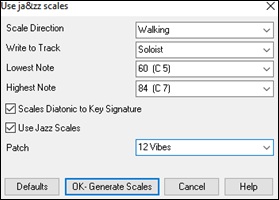
Scale Direction: When playing a new scale, either start on the root of the scale (going up) or start with the closest scale tone (moving up or down). The two modes are:
1. Ascending - The scales will always start on the root that is in the octave above the Lowest Note that is set and will play in ascending order.
2. Walking - The scales will start on the nearest scale tone to the previous tone that was played. The notes will ascend to the Highest Note setting, and then descend (by scale tones) down to the Lowest Note.
Write to Track: Choose Melody or Soloist track to write the scales to.
Lowest Note is the lowest note to play for any scale. C5 (note 60) is middle C.
Highest Note is the highest note to play, used when the scale direction is up and down (Walking).
Scale Tones Diatonic to Key Signature: If diatonic, minor scales will be according to the key (VI minor is Aeolian etc.). Otherwise all minors will be Dorian.
Use Jazz Scales: If set, will use Lydian b7 chords. Chords like Bb7 in the key of C will have Lydian b7 scales (i.e. A#4 in the scale).
Patch: Send this MIDI patch (instrument) when playing the scale.
[Defaults] sets to default values.
[OK- Generate Scales] writes the scales to the notation of the selected track, Soloist or Melody.
Unconditional 30-Day Money Back Guarantee on all PG Music products purchased from PG Music Inc.
PG Music Inc.
29 Cadillac Ave Victoria BC Canada V8Z 1T3
Sales: 800-268-6272, 250-475-2874,+ 800-4746-8742*
* Outside USA & Canada where International Freephone service is available.
Access Codes
Tech Support: Live Chat, support@pgmusic.com
 Online now
Online now
Need Help?
Customer Sales & Support
|
Phones (Pacific Time) 1-800-268-6272 1-250-475-2874 |
||
| Live Chat | ||
| OPEN | Online Ordering 24/7 |
|
| OPEN | Forums, email, web support |


